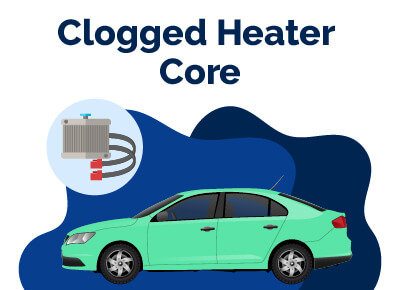Clogged Heater Core (Everything You Need To Know)
July 23, 2023


Chris is Head of Content for FindTheBestCarPrice and is based out of Philadelphia, PA. As a seasoned automotive industry analyst and car enthusiast, he ensures the highest level of quality across all our content and curates our picks for the best deals each month.
Chris studied information systems and marketing at Drexel University and writes about a wide range of topics ranging from car buying tips to troubleshooting common mechanical issues.
When he’s not thinking about cars, he likes to stay in with his dog and make an “attempt” to finish a crossword puzzle (he’s not quite at the Saturday/Sunday level…yet). As a former cheesemonger, Chris still has a “sharp” passion for all things cheese, and his fridge is always loaded with it!
Chris also has a passion for things that go fast, and drones are no exception. He spends some of his time writing for Dronesourced.
Is your car struggling to circulate warm air during chilly mornings or the winter season? The culprit may be due to a clogged heater core. The heater core's principal task is to propel heated air into the vehicle's interior via the blower motor.
When the heat is activated, the heater core pulls in hot coolant from the engine, and the blower motor channels air across the heater core tubes into the car interior through the air vents. As autumn fades and winter commences, frosty temperatures tighten their grip on a large portion of the nation.
This is when most drivers begin to appreciate their vehicle's warmth if their vehicle's warmth operates as expected. A lack of warmth during winter can create an excruciatingly cold commute.
Regrettably, an automobile's heating system is prone to occasional mechanical malfunctions, similar to its air conditioning system.
The lack of heat can stem from various issues that vary in severity. Nevertheless, only a few issues are as widespread or vexatious as that of a clogged heater core.
Table of Contents
How the Heater Core Works
Before diagnosing the issue, it is imperative to grasp the operational mechanism. Although the heater core is a component of the air conditioning system, it utilizes hot engine coolant that circulates to diffuse heated air into the cabin or defog the windshield.
The heater core resembles a small radiator, comprising tubes through which coolant passes and fins that enable air to flow across.
It harnesses the heat from the coolant to warm the air that will eventually be propelled into the car's cabin.
Specific vehicle systems have a valve regulating when coolant should stream into the heater core. Alternatively, other systems have coolant constantly streaming past it and merely activate a door or flap to enable air to enter the cabin.
The blower motor is responsible for forcing air into the cabin and becomes operational once the air conditioning system is activated.
The air is directed through the heater core should the user desire warmth. However, if cool air is desired, the air passes through the evaporator chilled by the refrigerant.
Symptoms of a Clogged Heater Core
Several telltale indications will appear to notify the driver of a clogged heater core, necessitating swift resolution. Presented below are some noteworthy symptoms:
1. High Coolant Loss
Should an excessive loss of coolant come to your attention, and you cannot deduce its whereabouts, the possibility of a leaking heater core may arise.
Regrettably, if the origin of the coolant leak evades detection, the culprit likely lies within the heater core, causing the coolant to drip into the cabin.
If this occurs when the system is unactivated, instead of creating fog on the windshield, it will generate a pool of liquid within the cabin.
Once a malfunctioning heater core becomes a suspect, conduct a visual scan of the passenger side floor. Should the floor mat be damp, accompanied by a pleasant odor, consider thoroughly inspecting the heater core.
2. If the Car Interior Is Foggy
An excessively misty car interior is a widespread indicator of a malfunctioning heater core. Is your car's interior mysteriously becoming foggy?
This does not refer to minor moisture on your car's windows and windshield but rather a warm condensation that covers all the windows completely.
One possible explanation for such significant moisture is a ruptured heater core. It is plausible that the heater core may rupture while driving down the road.
In such an instance, warm coolant will leak into the car cabin. The leaked, temperature-controlled coolant will then evaporate as steam, engulfing the car's interior with a dense fog.
3. Cold Passenger Compartment
Although a cold passenger compartment often signifies a defective heater core, it can also indicate other issues within the vehicle's heating system.
For instance, a malfunctioning blower motor or faulty components within the heater may be responsible and could be simpler to address than repairing or replacing the core.
Regardless of the underlying cause, if the passenger compartment remains cold despite the heat being turned on, it is evident that the heater core is at fault and needs to be remedied.
If there is a puncture or hole in the heater core, warm air will escape before reaching the ducts in the car interior, resulting in evaporated air that keeps the passenger compartment chilled.
Depending on the size of the puncture, the air that does reach the interior may be mildly warm, lukewarm, or even cold.
4. Odd Smell
Have you detected an unusual odor emanating from the cabin? While a defective heater core can often result in a foggy car, it is also possible for it to leak without causing window or windshield condensation.
However, such a leak can produce a pleasant melon-like scent from the vents.
This sweet fragrance results from the car coolant leaking into the cabin. If you detect this alluring aroma outside the vehicle, inspect the underside to determine the extent of coolant loss.
5. Overheating Engine While the Cabin Is Cold
Are you experiencing engine overheating coupled with a frigid passenger cabin? If so, it is imperative to assess the state of the heater core thoroughly.
Remembering that other system components can contribute to engine overheating is essential. In the event of warm air failure in the heater ducts and an overheating engine, inspect the cooling system for a potential coolant leak.
Overheating can lead to irreparable damage to vital engine components. Thus, it is vital to identify the root cause and rectify it promptly.
While driving, it is crucial to monitor your instrument cluster closely. If the temperature gauge starts creeping into the danger zone, park the vehicle in a safe location and determine the issue. If the problem persists, seek the services of a mechanic or tow the car to a garage.
Perhaps you may wonder, "Does a defective heater core affect the air conditioning system since it can cause overheating?" The answer is no. The heater core does not impede the AC from emitting cold air.
Causes of Clogged Heater Core
Several factors can be responsible for a clogged heater core. They include the following:
1. Corrosion
Corrosion and rust impede the cooling system from achieving optimal performance.
However, the detrimental effects are even more pronounced in heat exchangers when scale or rust accumulates within the system unit - including the heater core. Rust buildup can be attributed to the prolonged use of coolant in the radiator.
2. Faulty Thermostat
Although a defective thermostat may not give rise to a heater core obstruction, it can still hinder the smooth flow of warm air.
At the initial stage of the engine's operation, the thermostat remains shut until it attains the desired operating temperature.
After the engine has warmed up, the thermostat unlocks, permitting the circulation of cold coolant from the radiator to the engine and subsequently to the heater core.
3. Usage of Stop Leak Products
Many stop-leak products that claim to remedy coolant leaks with minimal effort are available in the market.
While these products may deliver on their promises, they can have detrimental consequences.
Frequently, such products can cause blockages in the cooling system components, including the heater core.
This is particularly common when users exceed the recommended dosage, which can result in the clogging of not only the heater core but also the radiator.
4. Oil/Coolant Mix
When oil and coolant combine, a sludgy mixture can cause rust within the car's cooling system.
As the coolant travels through the system's hoses and pipes, the sludge spreads to components, including the heater core.
Over time, this circulation can lead to a buildup of sludge that obstructs the flow of coolant, impeding its passage through the heater core.
How To Unclog a Heater Core
A blocked heater core can disrupt your driving experience, impeding the flow of warm air just when you need it on chilly mornings.
While clearing a clogged heater core is not rocket science, it does call for a step-by-step guide and an unclogging kit.
The initial stage is to identify the most convenient approach to locate the supply and return hoses of the heater core, which are typically positioned on the firewall.
The firewall connection represents the entry point for two hoses into the vehicle. By identifying these two hoses, you have located the heater core hoses.
If the firewall connection does not provide easy access, you may have to trace the two hoses from the engine to identify their location and disconnect them.
Examine the connections closely to determine which specific tool is required to detach the hoses. If the connection area is not well illuminated, utilize your underhood work light to brighten it up.
The tools needed to disconnect the hoses may include pliers, Phillips-head, or flat-head screwdrivers. Loosen the clips by unscrewing them and carefully twist the hose back and forth to free it before pulling it out.
Prepare your heater core unclogging kit in advance. Connect a garden hose to a water supply and attach a sprayer. Proceed to flush the heater core by spraying water into one end of the core.
Observe as dirty water flows out from the other end of the pipe. After a minute or two, switch the hose to the other end of the core and continue flushing. Repeat this process until clean water flows from both ends.
Elevate one of the hoses, procure a manufacturer-recommended coolant, and gradually pour it until you observe the liquid emerging from the opposite end of the hose. Proceed to reattach both hoses.
Inspect the coolant levels of the radiator and reservoir and replenish them as needed. Proceed by igniting the engine and allowing it to idle briefly.
Activate the heating system and monitor the temperature gauge attentively to prevent vehicle overheating.
Best Car Deals by Category
Posted in Car Buying Tips, Car Troubleshooting |




